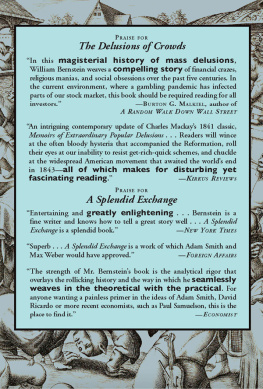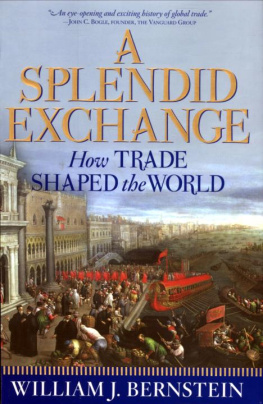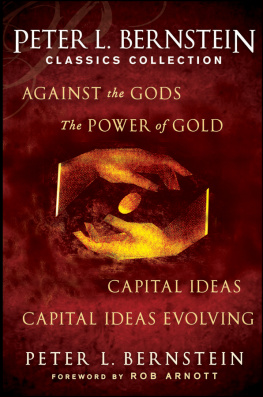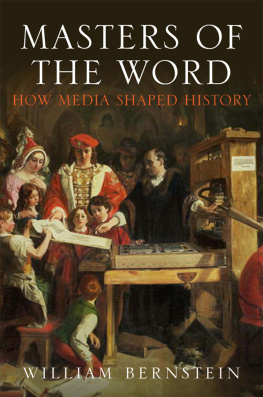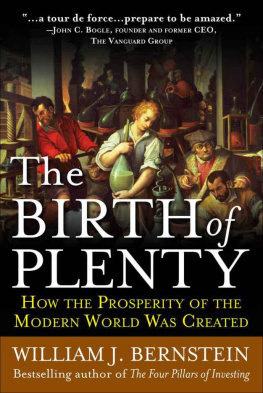William J. Bernstein - The Intelligent Asset Allocator
Here you can read online William J. Bernstein - The Intelligent Asset Allocator full text of the book (entire story) in english for free. Download pdf and epub, get meaning, cover and reviews about this ebook. year: 2001, publisher: McGraw-Hill Education, genre: Business. Description of the work, (preface) as well as reviews are available. Best literature library LitArk.com created for fans of good reading and offers a wide selection of genres:
Romance novel
Science fiction
Adventure
Detective
Science
History
Home and family
Prose
Art
Politics
Computer
Non-fiction
Religion
Business
Children
Humor
Choose a favorite category and find really read worthwhile books. Enjoy immersion in the world of imagination, feel the emotions of the characters or learn something new for yourself, make an fascinating discovery.

- Book:The Intelligent Asset Allocator
- Author:
- Publisher:McGraw-Hill Education
- Genre:
- Year:2001
- Rating:3 / 5
- Favourites:Add to favourites
- Your mark:
- 60
- 1
- 2
- 3
- 4
- 5
The Intelligent Asset Allocator: summary, description and annotation
We offer to read an annotation, description, summary or preface (depends on what the author of the book "The Intelligent Asset Allocator" wrote himself). If you haven't found the necessary information about the book — write in the comments, we will try to find it.
The Intelligent Asset Allocator — read online for free the complete book (whole text) full work
Below is the text of the book, divided by pages. System saving the place of the last page read, allows you to conveniently read the book "The Intelligent Asset Allocator" online for free, without having to search again every time where you left off. Put a bookmark, and you can go to the page where you finished reading at any time.
Font size:
Interval:
Bookmark:
The Intelligent Asset Allocator
How to Build Your Portfolio to Maximize Returns and Minimize Risk
William J. Bernstein


Copyright 2001 by McGraw-Hill Companies, Inc. All rights reserved. Except as permitted under the United States Copyright Act of 1976, no part of this publication may be reproduced or distributed in any form or by any means, or stored in a database or retrieval system, without the prior written permission of the publisher.
ISBN: 978-007-139957-9
MHID: 0-07-139957-7
The material in this eBook also appears in the print version of this title: ISBN: 978-007-136236-8, MHID: 0-07-136236-3.
All trademarks are trademarks of their respective owners. Rather than put a trademark symbol after every occurrence of a trademarked name, we use names in an editorial fashion only, and to the benefit of the trademark owner, with no intention of infringement of the trademark. Where such designations appear in this book, they have been printed with initial caps.
McGraw-Hill eBooks are available at special quantity discounts to use as premiums and sales promotions, or for use in corporate training programs. To contact a representative please e-mail us at bulksales@mcgraw-hill.com.
TERMS OF USE
This is a copyrighted work and The McGraw-Hill Companies, Inc. (McGraw-Hill) and its licensors reserve all rights in and to the work. Use of this work is subject to these terms. Except as permitted under the Copyright Act of 1976 and the right to store and retrieve one copy of the work, you may not decompile, disassemble, reverse engineer, reproduce, modify, create derivative works based upon, transmit, distribute, disseminate, sell, publish or sublicense the work or any part of it without McGraw-Hills prior consent. You may use the work for your own noncommercial and personal use; any other use of the work is strictly prohibited. Your right to use the work may be terminated if you fail to comply with these terms.
THE WORK IS PROVIDED AS IS. McGRAW-HILL AND ITS LICENSORS MAKE NO GUARANTEES OR WARRANTIES AS TO THE ACCURACY, ADEQUACY OR COMPLETENESS OF OR RESULTS TO BE OBTAINED FROM USING THE WORK, INCLUDING ANY INFORMATION THAT CAN BE ACCESSED THROUGH THE WORK VIA HYPERLINK OR OTHERWISE, AND EXPRESSLY DISCLAIM ANY WARRANTY, EXPRESS OR IMPLIED, INCLUDING BUT NOT LIMITED TO IMPLIED WARRANTIES OF MERCHANTABILITY OR FITNESS FOR A PARTICULAR PURPOSE. McGraw-Hill and its licensors do not warrant or guarantee that the functions contained in the work will meet your requirements or that its operation will be uninterrupted or error free. Neither McGraw-Hill nor its licensors shall be liable to you or anyone else for any inaccuracy, error or omission, regardless of cause, in the work or for any damages resulting therefrom. McGraw-Hill has no responsibility for the content of any information accessed through the work. Under no circumstances shall McGraw-Hill and/or its licensors be liable for any indirect, incidental, special, punitive, consequential or similar damages that result from the use of or inability to use the work, even if any of them has been advised of the possibility of such damages. This limitation of liability shall apply to any claim or cause whatsoever whether such claim or cause arises in contract, tort or otherwise.
On July 31, 1993, I came across an article in The Wall Street Journal (Your Money Matters series) which examined the performance of various asset allocations for the period 197392. The article was based on research done at the T. Rowe Price mutual fund group. The technique used was quite simple: imaginary portfolios were constructed from various combinations of U.S. large and small stocks, foreign stocks, and U.S. bonds, and returns and risks were calculated. The article pointed out that over the 20-year period studied various fixed mixes of the above assets outperformed the single component parts (as well as most professional money managers), with significantly lower risk. I was intrigued. T. Rowe Price kindly sent me the data underlying their calculations, which I analyzed. The results were astonishingalmost any reasonably balanced fixed combination of the four assets outperformed most professional money managers over the same period.
For example, a simpletons portfolio consisting of one quarter each U.S. large stocks, U.S. small stocks, foreign stocks, and U.S. high-quality bonds had a higher return, with much lower risk, than large U.S. stocks alone (represented by the S&P 500 index). The S&P 500, in turn, performed better than 75% of professional money managers over the same period.
I was fascinated by the T. Rowe Price data; here was a simple tool for ascertaining historical asset allocation performancecollect data on the prior performance of various asset classes, and backtest returns and risks. To my disappointment, I could find no readily available software which accomplished this; I would have to write my own spreadsheet files. I began to buy, beg, steal or borrow data on a wide variety of assets over several different historical epochs and build portfolio models going back as far as 1926.
The calculations performed by T. Rowe Price and myself contained an important implicit assumption: that the portfolios were rebalanced periodically. Rebalancing becomes necessary after a while because some assets in a portfolio will do better than others, and this will alter the original portfolio composition. In order to rebalance the portfolio back to its starting composition, some of the better performing assets must be soldand the proceeds used to purchase more of the poorly performing assets.
Most experienced investors learn that the key to long-term success lies in a coherent strategy for allocation among broad categories of assets, principally foreign and domestic stocks and bonds. They also understand that market timing and stock or mutual fund picking are nearly impossible long term. They are at best a distraction. Put another way, it is far more important to come up with the right proportion of foreign stocks, U.S. stocks, foreign bonds, and U.S. bonds than it is to pick the best stocks or mutual funds or to call the tops or bottoms of the markets. (As we shall see later, nobody consistently calls the market, and almost nobody picks stocks or mutual funds with any persistent skill).
If you find this difficult to believe, consider the following: 1987 was not a great year for the U.S. stock market. U.S. large company stocks (represented by the S&P 500) gained only 5.23% that turbulent year, and small company stocks actually lost 9.3%. On the other hand, foreign stocks gained 24.93%. The clumsiest foreign fund manager would have beaten the most skillful small-stock picker that year. In 1992, the opposite would have occurred when U.S. small stocks gained 23.35% and foreign stocks lost 11.85%. Finally, the 19951998 period provided unprecedented returns for the biggest U.S. growth stocks but battered almost everything else.
Still not convinced? In the late 1980s, Gary Brinson, a noted money manager and financial analyst, and his colleagues published two sophisticated statistical studies of 82 large pension funds. They concluded that asset allocation accounted for over 90% of the return variability among the funds, with a less-than-10% contribution from market timing and actual stock and bond selection.
Next pageFont size:
Interval:
Bookmark:
Similar books «The Intelligent Asset Allocator»
Look at similar books to The Intelligent Asset Allocator. We have selected literature similar in name and meaning in the hope of providing readers with more options to find new, interesting, not yet read works.
Discussion, reviews of the book The Intelligent Asset Allocator and just readers' own opinions. Leave your comments, write what you think about the work, its meaning or the main characters. Specify what exactly you liked and what you didn't like, and why you think so.

